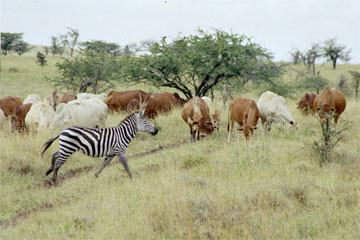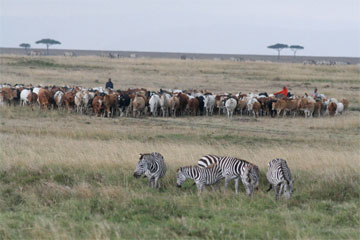Mingling with wild grazers, such as zebra, is better for cattle than dining alone—during the wet season, at least—according to researchers in Kenya. Their new study crumbles the longstanding assumption that social grazing always leads to food fights.
Kenya’s wildlife population is in a critical decline, partly due to kill-offs by ranchers who see zebra, wildebeest, antelope and other grazers strictly as competition for their cattle. But scientists at the Mpala Research Center in central Kenya suspected there might be natural accords between grazers.
In a study published in the September 23 issue of Science, the researchers evaluated the weight and diet quality of cattle that grazed in 10-acre plots with and without wild herbivores for 16 weeks. During the resource-strapped dry season, the cattle did indeed compete with wild grazers. But in the wet season, cattle gained more weight when they had company.
During the wet season, the researchers found, zebra indiscriminately mowed fibrous and dead stalks, called rank grass. This allowed persnickety cattle to get plump off the supple sprouts underneath.
 A zebra strolls past a cluster of cattle on the Kenyan savanna. Researchers say that letting zebra mingle with cattle during the wet season can improve cattle diet and weight. Photo by: Wilfred Odadi |
The study received attention for being the first to nail down any benefit to mixed grazing. But researchers do not suggest that ranchers send out dinner invitations to wild grazers just yet.
“It’s not clear that there’s a net benefit,” said ecologist Truman Young of the University of California at Davis, lead scientist of the study, in an interview with mongabay.com. He cautioned against letting the data promote any rigid approach to grazing policy, whether it’s that of cattle ranchers or conservationists. “Each of them can take half of the study and say, ‘See? That fits my agenda,’” said Young.
“At this point,” Young added, “the purpose is to show that the story is more complex than people had previously thought.”
Instead of perpetual turf wars, grazers pivot between clashing and clever coordination. As an example, Young described grazing successions in the nearby Serengeti. During the wet season, he said, zebra come through first and eat the coarsest grass, followed by wildebeest that eat the more moderate grass, and then gazelles that eat the shortest grass. “Each one would take advantage of what came before,” said Young.
Gracious grazers need not only be Serengeti wildlife, said Young, but wildlife and cattle, too. “It’s possible that any grazer can do this,” he said.
 Zebra and cattle share grazing space in Kenya’s savanna. Though researchers have found benefits to mixed grazing, the longstanding assumption that cattle and wildlife only compete has led ranchers to kill wildlife. Photo by: Rob Pringle |
“It’s not a new finding,” said ecologist Johan du Toit of the University of Utah, who wrote a commentary about the research in Science. “It’s a quantification of a hunch that we shouldn’t assume that wildlife is always a bad thing for livestock,” du Toit told mongabay.com.
Grazers willingly interact with one another in nature, said du Toit, so there must be some advantage to diverse dinner parties. “The value of having wildlife is not being realized,” said du Toit, “which is why it’s disappearing.”
The next step, he said, is to examine new methods to get the best of both ranching and conservation worlds by finding a way to cool off the dry season’s conflicts and boost the wet season’s benefits. For instance, scientists already know how to steer wildlife with controlled burns and water access.
Young agrees. “The idea would be to have the zebras show up when the grass is rank,” said Young, “and have them magically disappear when it gets dry.”
CITATIONS: Odadi WO, Karachi MK, Abdulrazak SA, Young TP. (2011) African Wild Ungulates Compete with or Facilitate Cattle Depending on Season. Science 333(6050): 1753-5. DOI: 10.1126/science.1208468
du Toit JT. (2011) Coexisting with Cattle. Science 333(6050): 1710-11. DOI: 10.1126/science.1212452
Beth Mole is a graduate student in the Science Communication Program at the University of California, Santa Cruz.